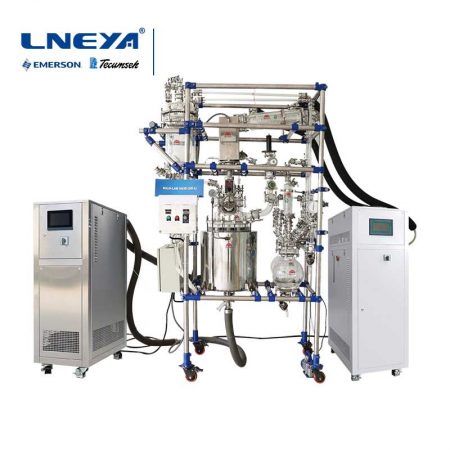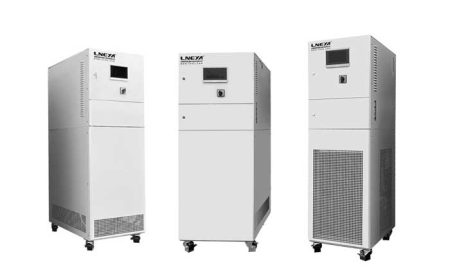Cooling Crystallization
Kontaktieren Sie uns noch heute für die perfekte Lösung zur Temperaturkontrolle
Cooling crystallization technology is a technical method commonly used in the processing and preparation of metal materials. By controlling the cooling rate and crystallization conditions of the material, the material crystallizes in the solid state to obtain a crystal structure with excellent properties.
The principle of cooling crystallization technology is based on the phase change laws of materials and the solid-state crystallization process. When a metal material is at a high temperature, its atoms or molecules will exist in a disordered manner, forming a liquid or gaseous state. When a material cools below a certain temperature, the atoms or molecules begin to rearrange themselves into an orderly, solid crystal structure. This process is called crystallization.
Cooling crystallization technology is widely used in the preparation of metal materials. For example, during the casting process, by controlling the cooling rate of the casting, castings of different shapes and sizes can be obtained. Rapid cooling can produce fine crystals, which can significantly improve the mechanical properties and surface quality of castings. Slow cooling can be used to prepare large pieces of metal materials to improve their plasticity and toughness.

Cooling crystallization process technology
The first is cooling rate control. The cooling rate of a material is a key factor affecting crystal formation and crystallinity. By controlling the cooling rate, the size and distribution of the crystals can be adjusted, thereby affecting the mechanical and physical properties of the material. Generally speaking, rapid cooling can form fine crystals and improve the strength and hardness of the material; while slow cooling is beneficial to the formation of large-sized crystals and improve the plasticity and toughness of the material. The control of the cooling rate can be achieved by adjusting the flow rate and temperature of the cooling medium. For example, in the cooling process of metal materials, different cooling media such as water quenching or oil quenching can be used to control the cooling rate.
The second is crystallization temperature control. The crystallization temperature of a material is the temperature at which the material changes from a liquid state to a solid state. During the cooling crystallization process, a suitable crystallization temperature can promote the formation and growth of crystals, thereby optimizing material properties. The control of crystallization temperature can be achieved by adjusting the temperature of the cooling medium or the heating method. For example, during the annealing process of metal materials, by controlling the annealing temperature and holding time, the crystal can grow at an appropriate temperature and the orientation and size of the crystal can be adjusted.
Wir bieten die Entwicklung und Herstellung kompletter Temperaturkontrollsysteme an. Von Standardmodellen bis zu kompletten kundenspezifischen Produkten bis hin zu 900 Tonnen. Wir haben uns auf den Kundenservice spezialisiert und sind bestrebt, jedem Kunden zu helfen, das optimale Temperaturkontrollsystem für seinen spezifischen Bedarf zu finden.
Wir bieten maßgeschneiderte Lösungen, die nicht dem Standard entsprechen. Es sind sowohl einzelne Kühlaggregate als auch kombinierte Kühl- und Heizaggregate erhältlich.
E-Mail: info@lneya.com WeChat ID: +8615251628237 WhatsApp: +86 17851209193

Rückkühler / Umwälzkühler
Die Kältemaschine kann in verschiedenen Industrien und Labors eingesetzt werden und unterstützt kundenspezifische Designs.
| Temperaturbereich | Serie -25°C ~ +30°C | -45°C ~ +30°C Reihe | Serie -60°C ~ -20°C | Serie -80°C ~ -20°C | Serie -120°C ~ -70°C | ||||
| Kühlleistung | 0,8 ~ 30kW | 0,75 ~ 12kW | 0,4 ~ 6kW | 0,2 ~ 6kW | 0,3 ~ 5kW | ||||
| Hinweis: Jeder Temperaturbereich von -150℃ ~ +350℃ und jede Kühlleistung kann angepasst werden | |||||||||
 Kaltwassersätze / Kleinkaltwassersätze
Kaltwassersätze / Kleinkaltwassersätze
Die Kältemaschine kann in verschiedenen Industrien und Labors eingesetzt werden und unterstützt kundenspezifische Designs.
| Temperaturbereich | -18°C ~ +30°C | +5°C ~ +35°C Reihe | |||||||
| Kühlleistung | 0,35 ~ 0,9kW | 1,8 ~ 50kW | |||||||
| Hinweis: Jeder Temperaturbereich von -150℃ ~ +350℃ und jede Kühlleistung kann angepasst werden | |||||||||

Niedertemperatur-Kühlgeräte
Wir haben uns auf die Herstellung von Niedertemperaturkältemaschinen mit einem Temperaturregelbereich von bis zu -150°C spezialisiert, die den Kühlbedarf verschiedener Branchen decken.
| Temperaturbereich | Serie -25°C ~ -5°C | Serie -45°C ~ -10°C | Serie -60°C ~ -10°C | Serie -80°C ~ -30°C | Serie -110°C ~ -50°C | Serie -150°C ~ -110°C | |||
| Kühlleistung | 12 ~ 360kW | 6 ~ 180kW | 6 ~ 180kW | 4 ~ 180kW | 2 ~ 120kW | 2,5 ~ 11kW | |||
| Hinweis: Jeder Temperaturbereich von -150℃ ~ +350℃ und jede Kühlleistung kann angepasst werden | |||||||||

Hochtemperatur-Kühlgeräte
Die Kältemaschine kann in verschiedenen Industrien und Labors eingesetzt werden und unterstützt kundenspezifische Designs.
| Temperaturbereich | +5°C ~ +40°C | -25°C ~ +40°C | -45°C ~ +40°C | -80°C ~ +80°C | -100°C ~ +80°C | ||||
| Kühlleistung | 6 ~ 40kW | 2 ~ 15kW | 1 ~ 8kW | 0,6 ~ 3kW | 1,5 ~ 3kW | ||||
| Hinweis: Jeder Temperaturbereich von -150℃ ~ +350℃ und jede Kühlleistung kann angepasst werden | |||||||||
Kühlen und Heizen Kaltwassersätze

Kühlen und Heizen Kaltwassersätze
Temperaturregelbereich: -120°C bis +350°C
Kühl- und Heizungsthermostate, die in verschiedenen Industriezweigen weit verbreitet sind.
| Temperaturbereich | Serie -10 ~ +150°C | Serie -25 ~ +200°C | Serie -25 ~ +300°C | Serie -45 ~ +250°C | Serie -45 ~ +300°C | Serie -60 ~ +250°C | Serie -60 ~ +300°C | Serie -70 ~ +250°C | Serie -80 ~ +250°C | Serie -90 ~ +250°C | Serie -100 ~ +100°C | ||
| Kühlleistung | 1,5 ~ 15kW | 1 ~ 200kW | 1 ~ 200kW | 0,45 ~ 200kW | 0,9 ~ 25kW | 0,25 ~ 60kW | 0,75 ~ 25kW | 0,4 ~ 15kW | 0,3 ~ 80kW | 0,2 ~ 80kW | 0,45 ~ 80kW | ||
| Hinweis: Jeder Temperaturbereich von -150℃ ~ +350℃ und jede Kühlleistung kann angepasst werden | |||||||||||||

Kühlgeräte mit Rücklaufheizung
Temperaturregelbereich: -45°C bis +250°C
| Temperaturbereich | Serie -25°C ~ +200°C | Serie -45°C ~ +250°C | |||||||
| Kühlleistung | 1 ~ 15kW | 0,25 ~ 15kW | |||||||
| Hinweis: Jeder Temperaturbereich von -150℃ ~ +350℃ und jede Kühlleistung kann angepasst werden | |||||||||
 LNEYA
LNEYA
 简体中文
简体中文


















































































